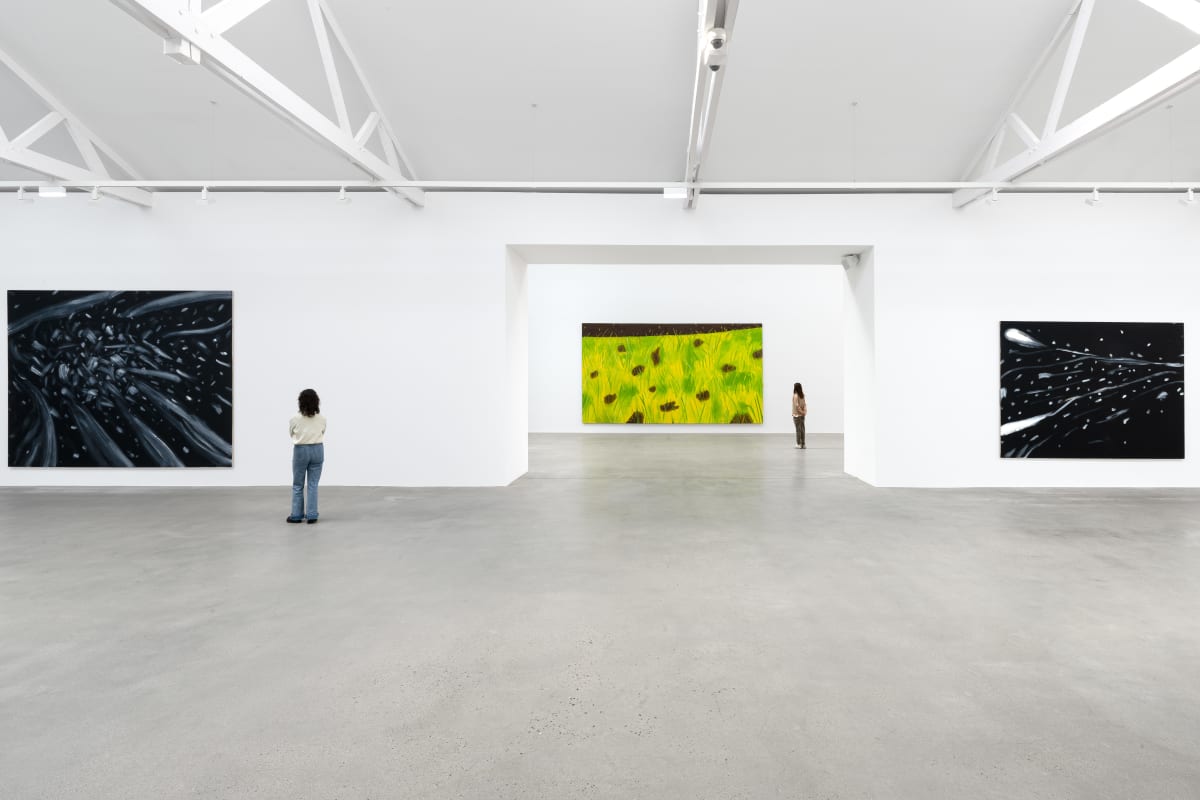Overview
Revisiting the legacy of Minimal art and Colour Field painting, this new series is characterised by its focus on a unique figure and a more gestural approach to colour, retaining traces of the brush in the densely textured surfaces.
Galerie Thaddaeus Ropac Paris is pleased to present an exhibition of new paintings and works on paper by Imi Knoebel in which the artist further explores the fundamentals of painting and sculpture. Revisiting the legacy of Minimal art and Colour Field painting, this new series is characterised by its focus on a unique figure and a more gestural approach to colour, retaining traces of the brush in the densely textured surfaces.
A group of large Figura paintings will be on display alongside new BIG GIRL paintings and a significant series of large-scale drawings, in which Imi Knoebel experiments with both form and colour. The exhibition highlights the creative process of the artist, whose work maintains a fine balance between improvisation and control. The Swiss art historian Dr. Max Wechsler, a close commentator of Imi Knoebel’s work, shares his viewpoint on the exhibition:
From the very moment an artist has made his work public, the perpetual questioning of his artistic practice can no longer leave him. Understandably, he tries to avoid it; in the case of the notoriously taciturn artist Imi Knoebel, perhaps he does so even more decidedly, for what reply could he give when his practice, embedded within his oeuvre, is so obviously displayed to the eyes of the public. Imi Knoebel’s activity is nothing else but the labour of his work, Imi Knoebel’s activity contains nothing else but his work, which he opens up to the perception and examination of the public. In this way, he doesn’t elude the question suggested in the title of this exhibition: 'was machen Sie denn' (‘What are you doing’). Since, in the course of his work, he is constantly involved within a process of self-reflection, where decisions are taken in response to the inherent logic and questioning of painting, wrestling with all of its contradictions, its doubts, and its joys. Thus the answer is revealed in the poetic reality of the work.
The work presented in the current exhibition all come from the artist’s most recent period. In the 36 drawings (Figur Z.1 – Figur Z.36) Knoebel sketches the preliminary field on which the subsequent paintings in this show are based. In the rectangular works on paper, Knoebel freely experiments with possible starting points for the painting series BIG GIRLS and Figurae (both acrylic on aluminum) to be realised. The BIG GIRLS, which are heavier and more compact, can appear as preparatory works for the more complex Figurae. On the level of drawing, he improvises within a delicate range of colours, but also undertakes a research of form, thus achieving a dynamic relationship between the centre and the edge of the painting, in paraphrases of self-similarity. A vibration that spreads through the glazed layers of paint, not least between surface and ground.
Originating from an intuitively motivated, freehand drawing, the forms or contours of the painting on aluminium, on the other hand, are given as clear figuration. The pictorial ground sets firm limits to the painting on aluminium, to which Knoebel more or less deals in his brushstrokes, but against which he can also rebel by opposing it with small-scale densifications, for example in Figura Ny, which becomes almost independent as an internal configuration. Of course, the painting on aluminum is also developed conceptually through its many layers, opening up from various viewpoints an array of constantly shifting textures. Last but not least, the principle of layering, together with the gestural dimension of the painting, brings into play the intensity of the richly differentiated colourfulness with its own magic.
Dr. Max Wechsler
About the artist
Born Klaus Wolf Knoebel in Dessau, Germany in 1940, Imi Knoebel grew up near Dresden until 1950, when his family moved to Mainz. From 1962-64, he studied applied art at the Darmstadt School of Arts and Crafts. Knoebel was strongly influenced by the theories of Johannes Itten and Lászlo Moholy-Nagy, which were taught at the Bauhaus in Weimar and Dessau. Between 1964 and 1971, he studied at the Staatliche Kunstakademie in Düsseldorf, where Joseph Beuys also taught. Having experimented with line drawings, light projections, and white paintings (1972-75), he used colour for the first time in 1974. The following year, Knoebel began his series of rectangular paintings in superposed layers of Mennige paint (industrial anti-rust paint). Thereafter, he started to juxtapose planes of vibrant and expressive colours upon different materials, predominantly working with wood and metal.
Imi Knoebel’s works are in prominent public collections including the Musée National d’Art Moderne, Paris; Dia:Beacon and Dia Art Foundation, New York; Bonnefantenmuseum, Maastricht; MMK, Frankfurt; Museu Coleção Berardo, Lisbon; The Broad, Los Angeles; MoMA, New York; MOCA, Los Angeles; Museo Reina Sofia, Madrid; Hamburger Bahnhof, Berlin; Norton Museum, West Palm Beach, and Sammlung Goetz, Munich.
Imi Knoebel has had monographic exhibitions since 1975 in Düsseldorf, Bonn in 1983, and Hamburg in 1992. Imi Knoebel participated in
documenta 5 (1972), 6 (1977) and 7 (1982). In 1996, the Haus der Kunst in Munich organised a large retrospective. In 2002, the Kestner Gesellschaft in Hanover celebrated its 75th anniversary with an exhibition of Knoebel’s work. In 2008, the Dia Art Foundation, Beacon, NY, presented his series 24 Farben - für Blinky (1977), and the Neue Nationalgalerie in Berlin showed some of his most important works in 2009. In 2011, Knoebel created six stained glass windows for the Reims cathedral in France. Major exhibitions have followed at Museum der Bildenden Künste Leipzig (2011), Kunstmuseum Wolfsburg (2014), Kunstsammlung Nordrhein-Westfalen in Düsseldorf and the Museum Haus Esters in Krefeld (both 2015), Musée Fernand Léger in Biot, France (2016), Skulpturenpark Waldfrieden, Wuppertal, Germany (2017) and Museum Haus Konstruktiv, Zurich (2018).










































































































































































